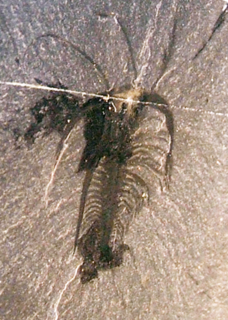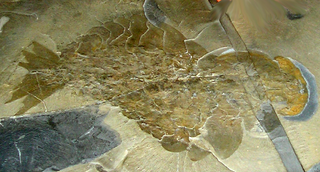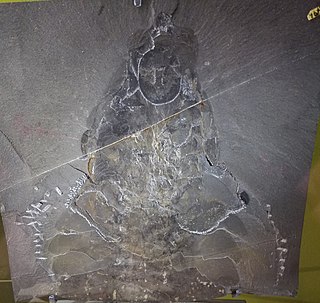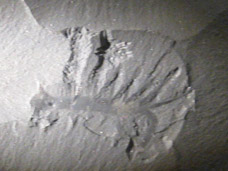
Marrella is an extinct genus of marrellomorph arthropod known from the middle Cambrian Burgess Shale of British Columbia. It is the most common animal represented in the Burgess Shale, with tens of thousands of specimens collected. Much rarer remains are also known from deposits in China.

Charles Doolittle Walcott was an American paleontologist, administrator of the Smithsonian Institution from 1907 to 1927, and director of the United States Geological Survey. He is famous for his discovery in 1909 of well-preserved fossils, including some of the oldest soft-part imprints, in the Burgess Shale of British Columbia, Canada.

Olenellus is an extinct genus of redlichiid trilobites, with species of average size. It lived during the Botomian and Toyonian stages (Olenellus-zone), 522 to 510 million years ago, in what is currently North-America, part of the palaeocontinent Laurentia.

Anomalocaris is an extinct genus of radiodont, an order of early-diverging stem-group arthropods. The first fossils of Anomalocaris were discovered in the Ogygopsis Shale of the Stephen Formation in British Columbia, Canada by Joseph Frederick Whiteaves, with more examples found by Charles Doolittle Walcott in the Burgess Shale unit of the Stephen Formation. Other closely related fossils have been found in the older Emu Bay Shale of Australia, as well as possibly elsewhere. Originally several fossilized parts discovered separately were thought to be three separate creatures, a misapprehension corrected by Harry B. Whittington and Derek Briggs in a 1985 journal article. With a body length close to 40 centimetres, A. canadensis is thought to be one of the earliest examples of an apex predator, though others have been found in older Cambrian lagerstätten deposits.

Peytoia is a genus of hurdiid radiodont that lived in the Cambrian period, containing two species, Peytoia nathorsti from the Miaolingian of Canada and Peytoia infercambriensis from Poland, dating to Cambrian Stage 3. Its two frontal appendages had long bristle-like spines, it had no fan tail, and its short stalked eyes were behind its large head.

Waptia fieldensis is an extinct species of arthropod from the Middle Cambrian Burgess Shale Lagerstätte of Canada. It grew to a length of 6.65 cm (3 in) and resembled modern shrimp in both morphology and habit. It had a large bivalved carapace and a segmented body terminating into a pair of tail flaps. It was an active swimmer and likely a predator of soft-bodied prey. It is also one of the oldest animals with direct evidence of brood care. Waptia fieldensis is the only species classified under the genus Waptia. Other specimens of Waptia are known from the Spence Shale in Utah.

Plenocaris plena is a Cambrian arthropod with a bivalved carapace, and is known from the Burgess shale and Chengjiang. Originally described as a species of Yohoia by Walcott in 1912, it was placed into its own genus in 1974.

The Burgess Shale, a series of fossil beds in the Canadian Rockies, was first noticed in 1886 by Richard McConnell of the Geological Survey of Canada (GSC). His and subsequent finds, all from the Mount Stephen area, came to the attention of palaeontologist Charles Doolittle Walcott, who in 1907 found time to reconnoitre the area. He opened a quarry in 1910 and in a series of field trips brought back 65,000 specimens, which he identified as Middle Cambrian in age. Due to the quantity of fossils and the pressures of his other duties at the Smithsonian Institution, Walcott was only able to publish a series of "preliminary" papers, in which he classified the fossils within taxa that were already established. In a series of visits beginning in 1924, Harvard University professor Percy Raymond collected further fossils from Walcott's quarry and higher up on Fossil Ridge, where slightly different fossils were preserved.

Lingulella is a genus of phosphatic-shelled brachiopod. It is known from the Middle Cambrian Burgess Shale (Canada) to the Upper Ordovician Bromide Formation in North America. 346 specimens of Lingulella are known from the Greater Phyllopod bed, where they comprise 0.66% of the community.
Leptomitus is a genus of demosponge known from the Middle Cambrian Burgess Shale. Its name is derived from the Greek lept ("slender") and mitos ("thread"), referring to the overall shape of the sponge. 138 specimens of Leptomitus are known from the Greater Phyllopod bed, where they comprise 0.26% of the community.
The Mount Stephen trilobite beds are a series of fossil strata on Mount Stephen, British Columbia that contain exceptionally preserved fossil material. Part of the same stratigraphic unit as the Burgess Shale deposit, many non-mineralized parts are preserved; in addition, a high density of trilobite fossils is present.

Eocystites was a genus of Cambrian stem-group echinoderm of Australia and Vermont.

Fordilla is an extinct genus of early bivalves, one of two genera in the extinct family Fordillidae. The genus is known solely from Early Cambrian fossils found in North America, Greenland, Europe, the Middle East, and Asia. The genus currently contains three described species, Fordilla germanica, Fordilla sibirica, and the type species Fordilla troyensis.

Salterella is an enigmatic Cambrian genus with a small, conical, calcareous shell that appears to be septate, but is rather filled with stratified laminar deposits. The shell contains grains of sediment, which are obtained selectively by a manner also observed in foramanifera. The genus was established by Elkanah Billings in 1861, and was named after the English palaeontologist John William Salter.

Bathyuriscus is an extinct genus of Cambrian trilobite. It was a nektobenthic predatory carnivore. The genus Bathyuriscus is endemic to the shallow seas that surrounded Laurentia. Its major characteristics are a large forward-reaching glabella, pointed pleurae or pleurae with very short spines, and a medium pygidium with well-impressed furrows. Complete specimens have never reached the size of 7 cm predicted by the largest pygidium found. Bathyuriscus is often found with the free cheeks shed, indicating a moulted exoskeleton. An average specimen will in addition have a furrowed glabella, crescent-shaped eyes, be semi-circular in overall body shape, have 7 to 9 thoracic segments, and a length of about 1.5 inches.

Fordillidae is an extinct family of early bivalves and one of two families in the extinct superfamily Fordilloidea. The family is known from fossils of early to middle Cambrian age found in North America, Greenland, Europe, the Middle East, Asia, and Australia. The family currently contains two genera, Fordilla and Pojetaia, each with up to three described species. Due to the size and age of the fossil specimens, Fordillidae species are included as part of the Turkish Small shelly fauna.

Fordilloidea is an extinct superfamily of early bivalves containing two described families, Fordillidae and Camyidae and the only superfamily in the order Fordillida. The superfamily is known from fossils of early to middle Cambrian age found in North America, Greenland, Europe, the Middle East, Asia, and Australia. Fordillidae currently contains two genera, Fordilla and Pojetaia each with up to three described species while Camyidae only contains a single genus Camya with one described species, Camya asy. Due to the size and age of the fossil specimens, Fordillidae species are included as part of the Turkish Small shelly fauna.

Salterellidae is a family of enigmatic fossil genera from the Early to Middle Cambrian. It was originally created for the genus Salterella by Charles Doolittle Walcott, who placed it in the group Pteropoda. It was later placed in Agmata, a proposed extinct phylum by Ellis L. Yochelson which is accepted by some other authors.

Hallucigeniidae is a family of extinct worms belonging to the group Lobopodia that originated during the Cambrian explosion. It is based on the species Hallucigenia sparsa, the fossil of which was discovered by Charles Doolittle Walcott in 1911 from the Burgess Shale of British Columbia. The name Hallucigenia was created by Simon Conway Morris in 1977, from which the family was erected after discoveries of other hallucigeniid worms from other parts of the world. Classification of these lobopods and their retatives are still controversial, and the family consists of at least four genera.
The Cambrian chordates are an extinct group of animals belonging to the phylum Chordata that lived during the Cambrian, between 485 and 538 million years ago. The first Cambrian chordate known is Pikaia gracilens, a lancelet-like animal from the Burgess Shale in British Columbia, Canada. The discoverer, Charles Doolittle Walcott, described it as a kind of worm (annelid) in 1911, but was later realised to be a chordate. Since the discovery of other Cambrian fossils from the Burgess Shale in 1991, and from the Chengjiang biota of China in 1991, which were later found to be of chordates, several Cambrian chordates are known, with some fossils considered as putative chordates.















